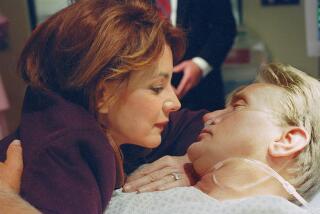Imagining the Kennedy Assassination : LIBRA: <i> by Don DeLillo (Viking: $19.95; 448 pp.) </i>
Like Conrad, Don DeLillo writes of political conspiracy as a disease. It is not the same disease. In Conrad, it infects the dissidents who seek violently to overturn a system. In DeLillo, it is the system that conspires and gets sick.
Besides, Conrad’s disease was deadly and relatively straightforward; pneumonia or tuberculosis. With DeLillo, our contemporary, it is deadly, elusive and polymorphous. Lupus, say, or acquired immune deficiency syndrome, with its connotation of Third World miseries striking back through First World practices.
“Libra,” a novel about the assassination of John F. Kennedy, is built upon the particular practice of “deniability.” From that administrative virus, invented to dissolve the constrictions of the old rule that “who wills the end, wills the means,” DeLillo cultivates a moral and political pandemic.
Although the author seems to be averse to the term, “Libra” is a form of fictionalized history. It has some of the form’s disadvantages, which I will get to, and the strengths, as well. In the hands of a writer of DeLillo’s fierceness and subtlety, the strengths are supercharged.
It has an additional advantage, owing to its subject. We have no solidly accepted factual history of Kennedy’s killing, though we have an infinity of facts. One of the best things in “Libra,” and one of its central symbols, is the wryly drawn figure of a man hired by the CIA to write the “secret history” of the assassination.
We glimpse him, from time to time, deluged with detail--photographs of Lee Harvey Oswald’s pubic hair, of his mother’s dental charts, of goat skulls smashed by bullets to demonstrate possible trajectories--and ever further from anything approximating a truth. Truth is a Penelope’s web whose completion is eternally postponed, not because it is undone, but because it is blurred by continually arriving skeins of new thread.
Using real figures, and others more or less invented to fill out his plot, DeLillo chooses and elaborates one frequently suggested version of the conspiracy theory. Simply put, the killing of Kennedy is the work of assorted anti-Castro activists who, by disguising it as a Cuban-backed effort, hope to provoke an American response more concerted and effective than the Bay of Pigs venture.
That is putting it simply, and DeLillo does not. The plot is at least two plots, piggybacking upon each other. Those involved include some dissident middle-level CIA officials heavily involved in the Bay of Pigs, and unable to accept the subsequent U.S. toning-down of the anti-Castro campaign, right-wing mercenaries, armed Cuban exiles, a former New Orleans police official, a Mafia overlord aiming to control gambling in a post-Castro Havana, and assorted odds and ends.
The oddest of these is Oswald, who comes drifting through in his balloon of self-exultation and misapprehension, intersects the various plots, and fits in perfectly with all of them. He is a nebulous leftist, a vociferous admirer of Castro, and has spent several years in the Soviet Union in protest against his own unprivileged portion of the American way of life.
Having, in his peregrinations, brushed up against several different intelligence agencies--the CIA, the FBI and the KGB--it is not hard to devise a confected paper trail linking him to the Cubans. As for enlisting this unstable man, who rather admires Kennedy, it is enough to convince him that the U.S. government is making plans to assassinate Castro.
DeLillo disassembles his plots with the finest of jigsaw cuts, scrambles their order and has us reassemble them. As the assorted characters go about their missions, we discern them more by intuition than by perception. The chronology goes back and forth, disorienting us. We do not so much follow what is going on as infiltrate it.
The author has constructed the shifting segments of a conspiracy that changes shape as it goes along. The original notion, devised by a disaffected CIA man on extended leave for excessive zeal, would have had the assassin miss. An associate, directly in charge of the operation, as he was at the Bay of Pigs--and therefore more bitter about the “betrayal”--simply switches the arrangements.
DeLillo’s paranoid grid is much larger. The operatives may be “renegade” CIA men, but the agency has its own contacts with an armed exile group that is also planning a Kennedy assassination. At the same time, the FBI is working to frustrate the exiles’ activities.
At one extraordinary point, an FBI man approaches Oswald to infiltrate the right-wing group that is involved in the assassination. A leftist, he is to pretend to be a rightist and to offer to pose as a pro-Castro activist in order to furnish the rightist group with information on the left. The real purpose, of course, is to report the rightists’ activities to the FBI. It is a masterpiece of stunning dislocation, and in the middle of it, the FBI man apologetically declines a cup of coffee because J. Edgar Hoover is on an anti-stimulants kick.
The picture, once the pieces drift together, is of a wavering line leading from the top of the government to the intelligence agencies, down through a morass of white, gray and black operations, out into assorted extremist groups and individual nut cases, and finally to the demented, oblivious figure of Oswald himself.
Things are set in motion, contacts made, plans bruited. A policy may be changed or canceled--or seem to be--but its segments have acquired a life of their own. DeLillo’s stunning portrait is a schema of the methods and consequences of deniability as governance.
Top-level government committees meet and adjourn after setting general policies; one or two members of the committee meet with an operations committee whose discussions are more concrete; one or two members of this committee meet a lower-level, still more concrete, and proportionately bloodiercommittee, until the exploding cigar and botulism-tipped needle is arrived at.
The higher you are, the less you are to know. “Knowledge was a danger, ignorance a cherished asset,” DeLillo writes. Senior officials “expected to be misled; they counted on it.” Deniability is alluring and effective until something goes wrong; then it goes fearfully, uncontrollably wrong; and its dementia, which has already sickened the processes of government, assassinates them.
Chilling and penetrating as it is, and for all its fascination, “Libra” has its defects. Some of the characters may be invented, and the real ones may have fictional attributes; still, they all must schedule themselves to the demands of the real as against the fictional event. It is like touring Paris with so many appointments to keep that the sense of travel is curtailed.
Most of the figures in “Libra,” however suggestive when we first meet them, fade into their functions. There are exceptions. Jack Ruby, expansive and crooked, exploiting his friendships--largely imaginary--in the Mafia and the police, is a beautifully written sketch, as beguiling and sickening as junk food. Oswald’s wife, Marina, drawn with the lightest of strokes, has a persistent life to her. Oswald is the most haunting of all. Alternating with segments of the plotting, we follow his zigzag life in detail. Poor, uneducated, incompetent, he is moved by a burning need to achieve something against the grain of wherever he finds himself. He studies Marx and Engels despite his reading difficulties, enters a vague arrangement with a Soviet agent while working as a radar operator in Japan, moves to the Soviet Union, becomes frustrated there, turns Trotskyist, tries to go to Cuba.
“He wanted to carry himself with a clear sense of role, make a move one time that was not disappointed,” DeLillo writes of Oswald in Dallas. “He walked in the shadows of insurance towers and bank buildings. He thought the only end to isolation was to reach the point where he was no longer separated from the true struggles that went on around him. The name we give this point is history.”
It is a clear fix among the shadows. Oswald comes to us as a white whale mutely signaling his lifelong mission to bring down Ahab. He is a ghostly prodigy whose instincts and compulsions are faintly recognizable, as belonging to a fellow mammal, but also remote and unfathomable, as suited to the submerged white form and the cold depths and fishy companions he frequented.
More to Read
Sign up for our Book Club newsletter
Get the latest news, events and more from the Los Angeles Times Book Club, and help us get L.A. reading and talking.
You may occasionally receive promotional content from the Los Angeles Times.







